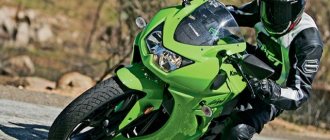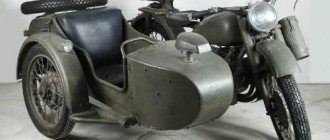New technologies are advancing across the planet by leaps and bounds. And sometimes they even go... And what do you think? Even on unicycles! Yes, yes, this transport is not a figment of the imagination of science fiction film scriptwriters, but today’s reality. Moreover, some one-wheeled motorcycles are already being mass-produced, going on sale, acquiring owners and roaming the streets. What’s surprising about this if the pace of life in big cities dictates its own conditions? Nobody wants to be stuck in traffic jams for hours, and traffic jams are not scary for a unicycle. Maneuverable and lightweight, it will overcome any traffic jam, and if necessary, it can be taken out of a crowd of people and cars simply in your hands. What is this amazing transport, how does it work and who rides it? Let's talk about everything in order.
Historical background, or First attempts
Enthusiasts are the ones who drive progress! Where a professional will say: “This is impossible!”, an amateur inspired by a dream will try again and again until he achieves a result. This is exactly how the amazing development of Italian technicians appeared back in 1923. The wheel diameter was 14 feet, and, according to contemporaries, this vehicle could reach a speed of one and a half hundred kilometers per hour! Its most amazing feature is the position of the pilot inside the wheel.
Is there a future for unicycles?
Of course, this is not all of the existing unicycle motorcycles. In addition to the impressive number of mass-produced models, many concepts have also been developed that are not yet in production.
By the way, did you know what unicycles are called? The most commonly used names are “monobike” and “unicycle”. Some experts believe that it is generally incorrect to classify such vehicles as motorcycles. Perhaps, with the development of technology and the emergence of even more options, it will be possible to talk about a new type of vehicle.
All currently existing options operate on environmentally friendly electric motors. This makes monobikes even more attractive, because humanity is finally seriously concerned about preserving the environment. No less important are indicators such as efficiency, maneuverability, and compactness.
Well, let's hope that this convenient transport will occupy its niche and in the future will become more accessible to a wide range of buyers.
Segway prototype
Today, most people know the word “Segway”. This particular vehicle is the prototype on the basis of which modern one-wheeled motorcycles were developed. “What is similar about them if the Segway is two-wheeled?” - you ask. It's all about the principle of maintaining balance. Both of these seemingly unstable vehicles operate on the same principle. Their center of gravity is located in a position that allows them to maintain stability and trajectory stability while driving. Both of them weigh relatively little, develop approximately the same low speed, and operate on batteries.
3mysterious photo
You may be interested in: What is a QR code and how to use it?
True, the claims that Signor de Udine was the first are controversial. The archives of one of the French libraries contain a photo of a lady sitting inside a similar vehicle, dated 1927.
The most amazing thing is that the wheel design is identical. Perhaps this is the same specimen, and not two different ones. Whether there was a fact of plagiarism, whether the developers knew each other, or whether two people almost simultaneously invented the same thing - history, unfortunately, is silent about all this.
Leading Manufacturer – Ryno
Please do not confuse it with Renault! These are completely different brands.
Developer Chris Hoffman began work in 2008 and very soon introduced the world to his unusual motorcycles with one wheel. The story of their appearance is also incredible - the idea came to the mind of Hoffman’s daughter. It was she who drew the sketch and begged her father to make an unusual vehicle for her. The designer was inspired by this idea and began development. And very soon a small family hobby turned into a big family business. This is how the Ryno was born - a one-wheeled motorcycle considered the best in the world.
Monocats: five amazing cars with one wheel
Oddly enough, the idea of using only one wheel in moving carriages originated about a century and a half ago and has already undergone several stages of development, including its own renaissance. But the fact that we can now all buy an autonomous single-wheel platform Airwheel with a tiny power reserve does not mean that such projects have ceased to develop. On the contrary, even global brands have joined their development, which already hints at future prospects. In the meantime, I propose to get acquainted with the most amazing devices that enthusiasts have collected in their garages during this time. Let's check our vertical stability and let's go!
March of the Lonely
The strange inventors who fell in love with only one wheel in “mobiles” can be called lonely not only for the nature of their projects, but also for the general misunderstanding that they encountered. In total, from 1867 to the present day, the total number of patented vehicles with a unicycle has exceeded 40. However, many of these designs turned out to be so tricky from a technical point of view that they are doomed to remain on paper even now. And those that did see the light of day can be counted on one hand.
1 / 4
2 / 4
3 / 4
4 / 4
The first clear design for a “unicycle,” or a bicycle with one wheel, appeared in 1884. The author of it did not make it into history, because... It was not possible to identify him. But the concept of transport he proposed became the starting point for further research into unicycle transport. And the next similar project was registered 20 years later, in 1904, already with a gasoline engine on board. In addition to the equipment, the name of the unicycle has also changed - unicycle. Really, it started to sound more thorough? In 1910, one of the first such devices embodied in metal was the Edison-Pouton monocycle, built in France. It has not survived to this day, but the German F. Schlenker presented a fully working copy of this machine. Its single wheel is driven by an authentic De Dion single-cylinder petrol engine with a capacity of 150 cm³ and a power of 3.5 liters. With.
1 / 3
2 / 3
3 / 3
In 1911, a patent was issued for a unicycle with an installed pusher propeller from the American Tom Coates Clinton. This time, the “progressive” transport was a huge, human-sized wheel with an internal frame to which the motor was attached, as well as a platform with a seat and stabilizing wheels. The premiere of the device was organized at the Milan exhibition, which was documented in detail by the newspaper La Vie de l'Automobile. And although the monocycle plunged the respectable public into shock and awe, the invention was not allowed to proceed.
Peculiarities:
At the beginning of the twentieth century, humanity was skeptical even about four-wheeled cars, considering them a newfangled curiosity. What can we say about monocycles, in which people almost saw alien ships. And although their images inspired many illustrators, the future for such transport in those years was predetermined.
Dynasphere
This project arose in 1932 and turned out to be so large, no, simply gigantic, that it more than once forced its creator to change his underwear. Indeed, in the fight against the low stability of one-wheeled vehicles, Dr. John Archibald Purves did not come up with anything better than using a wide load-bearing frame in the Dynasphere design. The result was a three-meter steel wheel weighing about 450 kg, with which Dr. Purves tried to replace the entire automotive industry on the planet.
1 / 2
2 / 2
Fortunately, according to the doctor, the industrial revolution did not happen. When tested, the Dynasphere megawheel turned out to be even more stable than its creator expected. There was no steering control at all, and in order to set the trajectory of this device at a speed of 40 km/h, the driver had to deviate to the right or left, thereby shifting the Dynasphere’s center of gravity. Is it necessary to talk about all the dangers of such movement?
1 / 2
2 / 2
However, Purves was not only a fan of spherical travel - there was also a practical streak in his character. Watching the onlookers scatter away from his huge unicycle, the doctor decided to simplify the process of driving it. The second version of the Dynasphere turned out to be a two-seater crew, powered by a 6-horsepower gasoline engine. The driver's platform, which also housed the passenger and the power unit, was equipped with a suspension with an adjustable angle of inclination relative to the wheel. This made it possible to control the movement of the Dynasphere as in a regular car, i.e. turning the steering wheel. Proud of his discovery, D. A. Purves modernized the Dynasphere, developing a platform for transporting five or even eight people! Such capacity was impressive, but the doctor was unable to fully staff the crew for new tests.
Peculiarities:
For all its grotesqueness and awkwardness, Dynasphere significantly accelerated the development of unicycles. After all, by cutting off the ball on both sides relative to the center, Dr. Purves eliminated the main drawback of such transport - its instability.
Biker and his laziness
In fact, 47-year-old Kerry McLean is a die-hard fan of motorcycles, speed and extreme riding. But still, building a custom bike with two hooves turned out to be a much more difficult task for him than making a one-wheeled vehicle from scrap materials. The American liked the idea so much that he soon switched from a homemade homemade product to a legal production that was in demand by the eccentric public!
The first unicycle assembled by McLean was a modified tractor wheel with a diameter of about 90 cm. The enthusiast equipped it with a water-cooled gasoline engine with a capacity of 40 “horses”. This was quite enough to accelerate to 100 km/h in an outlandish device and get into the Guinness Book of Records. The biker never left the pages of the local tabloids for another reason: his invention became the first unicycle officially registered by the Michigan State Highway Patrol.
1 / 2
2 / 2
The design solutions applied by McLean far surpassed the experience of previous unicyclists. According to the inventor, his car is devoid of the biggest drawback of single-wheeled vehicles: even with sharp braking, the driver does not roll over his head, but only leans forward a little. The device turned out to be so successful that Carrie even founded his own company, McLean Wheel, and designed a low-power (5 hp) and completely safe commercial model based on the record-breaking prototype. By paying $8.5 thousand, any extreme sports fan can literally find himself in the center of the action! At the same time, McLean saved the “heavy artillery” for his own needs: several exhibits equipped with a V-shaped “eight” from Buick Wildcat, McLean V8 and McLean V8 Rocket Roadster cars settled in his garage. Their power is wisely not indicated by the author, but we know that such cars were equipped with engines with a potential ranging from 325 hp. With. up to 370 l. With.!
Peculiarities:
Kerry McLean's achievements turned out to be as successful as they were impressive: not only did the inventor move the evolution of unicycles off the ground with his McLean Wheel for the first time in 60 years, he also managed to make good money on it! And constant experiments with engine volume clearly lead him to a new speed record in this area. One can only rejoice at Mr. McLean’s lack of emotional health, because a normal person, being inside a madly rotating wheel, at a planned future speed of 160 km/h, clearly will not survive...
One Wheel Riot
In the twentieth century, the entire history of the unicycle was built around the fact that the driver of this vehicle sits inside the wheel. But in 2003, inventor Jack Lyall made a real revolution by installing a pilot's seat on the outside of a unicycle. All the technical stuff remained in its original place, which turned the already strange vehicle into a hero of post-apocalyptic films. D. Lyall called his creation RIOT Wheel, which means “ReInvention Of The Wheel”.
This device is designed very cleverly. To give it stability, Lyall placed a movable counterweight weighing 204 kg inside the wheel. Regardless of whether the unicycle is idle or riding, it always takes a position to balance the seated rider. Honda engine with a volume of 800 cm³ and a power of 6 hp. With. installed on the same principle and is capable of changing its position inside the wheel regardless of the first counterweight. When accelerating, it itself deflects forward (or backward when braking) in proportion to the developed torque (braking) torque.
Despite its unkempt appearance, Mr. Lyall's RIOT Wheel addressed a number of key unicycle shortcomings. The forward seat prevented the driver from being injured by stones and sand flying from under the wheel, and also did not limit his visibility in any way. In “classic” unicycles, part of the road was always hidden by the rim.
The width of the wheel itself also plays a significant role in giving stability to the RIOT Wheel. The unicycle is also equipped with a 30-kilogram gyroscope, which, reacting to the force of the steering handles, is capable of deflecting horizontally and changing the trajectory of its movement. As a safety control element, the driver's seat has a play of 15º in both directions, which can also set the RIOT Wheel in the required direction. According to the inventor, the deviation of the center of gravity of the unicycle is sufficient to realize the full torque of the engine and intensive braking up to the point of skidding. With a total weight of half a ton, the device reaches a speed of 46 km/h.
Despite its unkempt appearance, Mr. Lyall's RIOT Wheel addressed a number of key unicycle shortcomings. The forward seat prevented the driver from being injured by stones and sand flying from under the wheel, and also did not limit his visibility in any way. In “classic” unicycles, part of the road was always hidden by the rim.
Jack Lyall decided to build this unicycle just for the sake of the Burning Man festival, which is held annually in the Black Rock Desert, Nevada. All lovers of technological and aesthetic mischief come to the event. And of course, the invention of the RIOT Wheel was liked by the local public. Lyall was not ready for the public success of his prototype - instead of resting on the laurels of the first tester of the “reinvented wheel”, he sat down in the garage with new developments.
Peculiarities:
Captivated by a random idea, Jack Lyall announced online that he was going to improve the RIOT Wheel, making it lighter and faster. Instead of a simple internal combustion engine, the inventor plans to use powerful electric motors that would make this unicycle the fastest existing in the world. Lyall even collected donations for this project. It’s just that he apparently used the funds from them “to the side”, because the “reinvented wheel” never set any records.
Electric scooters
To say that the fate of the unicycle did not work out from the very beginning means to say nothing. If you depict it on a diagram, it will be a smooth straight line with rare “flashes” from enthusiastic inventors. No one was seriously involved in this type of transport, but in 2010 the company Ryno Motors set out to correct this.
Then engineer Chris Hoffmann announced the serial production of a one-wheel electric scooter of his own design. According to estimates, the cost of one unit of such equipment did not exceed $3,500, but the launch of Ryno into mass production was postponed over and over again. In the fall of 2011, there was talk of releasing a limited edition of 50 copies. These unicycles, costing $25,000 each, were to be hand-built and serve as an advertisement for the upcoming mass production.
1 / 2
2 / 2
Why was Mr. Hoffmann even confident that his new company would benefit from this idea? It's simple: the engineer examined all the mobile devices existing at that time and, having highlighted their shortcomings, realized that a monocycle almost completely eliminates them. A Ryno pilot's legs don't get tired, unlike Segway users. It is light, compact, and easy to use. The curb weight of this unicycle is 57 kg. A full battery charge is enough to cover a distance of 48 km at a speed of about 40 km/h. In addition, you can charge Ryno from a regular outlet: to do this, you do not need to drag the entire “scooter” into the house; you just need to remove the battery from its case.
In addition, the new unicycle showed good maneuverability. Journalists who tested the first models claimed that you could learn to operate the Ryno in just a few minutes. Thanks to sensors hidden inside the carbon body, the unicycle itself maintains its stability while driving. They are also responsible for the acceleration/deceleration that occurs with the device when the driver leans forward or backward. You can turn to the sides using the most ordinary motorcycle steering wheel, which also has a brake lever and an accelerator button.
Peculiarities:
Ryno Motors - the creators of the unicycle of the same name - are serious. They are confident that they have created another niche product that will appeal to all fans of compact transport. This one-wheel electric scooter makes commuting easy and comfortable, and the ability to slow down to a leisurely pace allows you to use the Ryno even indoors. At the same time, the unicycle is not afraid of traffic jams, does not pose problems with parking and does not need to be refueled with expensive fuel. Perhaps, reader, you are now looking at the true transport of the future?
Solowheel - for those who stand firmly in the stirrups
It is noteworthy that the new development of the Inventist company - the Solowheel unicycle motorcycle - was presented to the general public at the prestigious toy exhibition in New York. However, this transport is not a toy at all. The Solowheel comes with a charger, is easy to assemble and disassemble, and is fairly inexpensive (about $250).
It differs from the Rhino in the complete absence of control systems and saddles. Riding it is carried out due to the distribution of the pilot’s own weight. And these unicycle motorcycles can accelerate up to 20 km/h.
General impression
Overall, the device looks pretty nice and is perfect for driving around the city. A fairly decent power reserve allows you to use it for commuting. However, in the case of office work and any work where there is no convenient indoor parking, the Ryno will become a burden. In fact, you have half a motorcycle in your hands that needs to go somewhere. It is unlikely that such a structure will be left protected. Just fastening it to a lamppost with a padlock is a bit scary. Still, 5000 USD, which is equivalent to just an excellent bicycle or a good electric bicycle. For the same money you can buy a used foreign car in good condition.
This device is also not particularly suitable for suburban use. Throwing 60 kg into an electric train is quite problematic. Of course, if you have a personal car, you can take the Ryno to the riding area in the trunk, and then continue driving on it. But this motorcycle will not pass through the forest. It turns out that the last use case is riding in the evening in a park with paths and commuting to work if parking is available. You can go to the store at your dacha. Therefore, this technical innovation at the moment can hardly be more practical than the most ordinary electric bicycle.
Uno that even a child can handle
Eighteen-year-old genius Ben Gulak once came up with a completely unusual vehicle - a motorcycle on a twin wheel. His brainchild was named Uno.
The uniqueness of the model is that the vertical position is ensured using gyroscopic technology, and each of the twin wheels is connected to an electric motor and has an independent suspension. This design ensures an even distribution of energy throughout the system.
Ben Gulak's unicycles have a fairly simple design, very simple controls and are light in weight. The pilot only needs to control the steering wheel directly. To go forward, you need to lean slightly, and to brake, you need to lean your body weight back. According to the talented developer, who even developed spare parts for motorcycles on his own, even a child can control the Uno.
How to ride a Ryno?
Even a novice user will not have any problems with control. After all, as we already wrote above, the motorcycle is equipped with a built-in gyroscope and a balancing system. In addition, the wide wheel gives great confidence when moving. To acquire the necessary skills, it is enough to drive in a straight line a couple of times. Otherwise, this equipment is more than obedient and is no more difficult to control than a Segway. The technique is absolutely safe. In addition, even turning the device on its side will not be very easy - after all, the gyroscope provides stability in all directions. Ryno will begin to steer itself if there is a sudden stall.
High Speed Hornet
These unicycle motorcycles weigh more than their analogues - as much as 176 kg. But the speed they develop is simply incredible! Developer Lime Ferguson assures that the Hornet can accelerate to 230 km/h.
In terms of its design, this motorcycle is very similar to the Segway; it has the same twin wheels and motor located on a single axis. Gyroscopic sensors control the system.
Ryno driving characteristics and operating features
The maximum speed of RYNO is currently 30 km/h. Despite the bulky design, the entire device weighs about 55 kg. The range on one battery charge is 40 km. This is not enough, but more than enough for city trips. And for nearby country trips it is more than suitable. If you compare this figure with an electric bicycle or unicycle, then the mileage figure for the standard Ryno is approximately twice as much as for a bicycle.
The Ryno can carry a load of 100 kg and easily climbs up to 20 degrees.
Ryno is equipped with shock absorbers, which makes driving this wonderful vehicle comfortable and soft.
Stoppie.
Stoppie is also one of the basic tricks often performed on a motorcycle by both stunt riding professionals and amateurs. The trick consists of riding a motorcycle on the front wheel (Rolling Stoppie), or hanging on the motorcycle in a “candle” while standing on the same front wheel (Regular Stoppie).
The motorcycle fork is suddenly loaded, the front brake is applied... And that’s it! It all depends solely on the skill of riding a motorcycle and the feeling of traction of the front wheel with the surface.
More difficult stoppies involve performing the trick with one arm, no legs, standing on the tank or on the saddle, stoppie while turning and descending. A separate complex version of Stoppie is the Quite popular among professionals and very spectacular Stoppie Kiss and its variations, designed for pinpoint accuracy in stopping a motorcycle.
2.1. 180/270/360 Stoppie, Kangaroo (Kangaroo).
This type of stunt involves turning a motorcycle on the front wheel. Moreover, if with 180/270/360 Stoppie the rider walks in an arc, turning to the appropriate angle, then when performing Kangaroo he also jumps, turning in the buckle, at the moment the fork begins to unclench and, additionally, pushing off the ground with his weight.
2.2. High Chear Stoppie, No Hand Stoppie, No Foot Stoppie, Side Saddle Stoppie.
Stunt tricks in stoppies, performed while sitting on a gas tank, without hands (hands are removed from the steering wheel after the motorcycle has stopped, and the earlier, the higher the rider’s class), stoppies without legs and stoppies with legs thrown over one side of the motorcycle, respectively.
Although in the video we can see another interesting performance of No-hand stoppie.
2.3. Stoppie park.
Just one of the options to park a motorcycle











